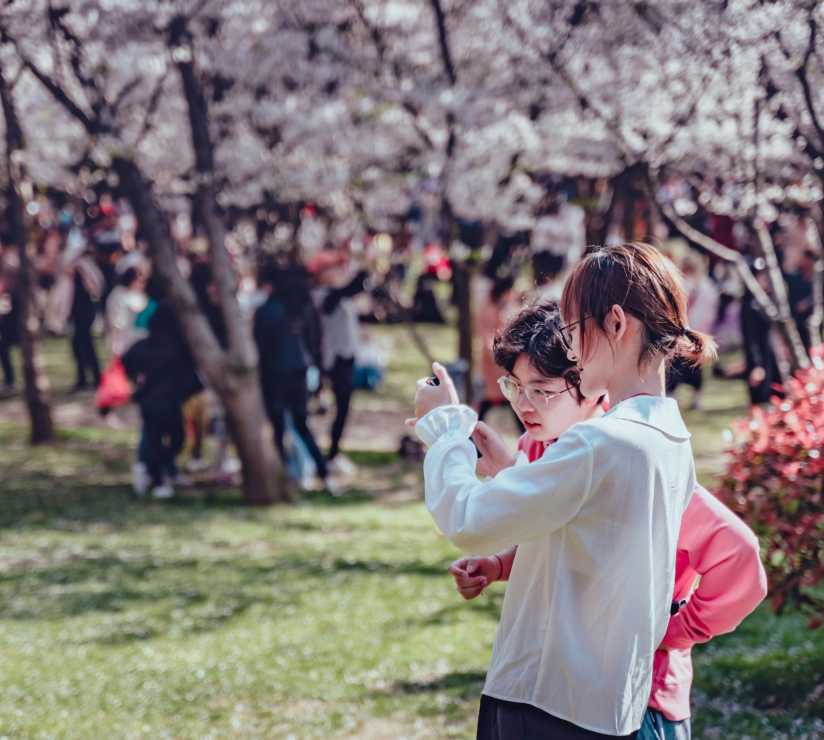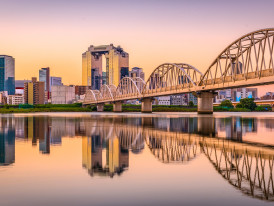
A wide shot of Osaka skyline at sunset with Umeda Sky Building in view
By Daiki Morimoto
Osaka's flavors, jokes, and ballparks — all in one breath.
Look, I could tell you Osaka is Japan's third largest city and leave it at that. But that's not why you're here, and frankly, it's not why I keep coming back to my hometown every chance I get. After twenty-eight years of breathing this city's air, eating its food, and getting lost in its maze-like streets, I've got some honest reasons to visit Osaka that go way beyond what you'll find in your typical guidebook.
This isn't going to be some polished travel piece where I pretend every moment is Instagram-perfect. Osaka is messy, loud, and sometimes frustrating. It's also the most genuine slice of Japan you'll ever taste. So grab a beer, settle in, and let me tell you why this city gets under your skin and never lets go.

Early morning scene at Kuromon Ichiba Market
They call Osaka the "nation's kitchen" for a reason, and it's not just marketing fluff. When I was seven, my grandmother dragged me through Kuromon Ichiba Market at 6 AM, teaching me how to spot the freshest seafood by the clarity of the fish eyes. That morning changed everything I thought I knew about food.
The street food here isn't just sustenance – it's theater. Watch an okonomiyaki chef work their magic on the griddle, and you'll understand what I mean. The sizzle, the flip, the perfect timing – it's performance art you can eat. I've seen tourists stand mesmerized for twenty minutes just watching the process unfold.
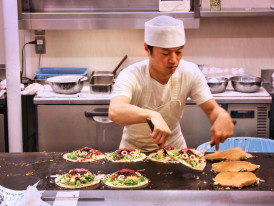
Chef preparing okonomiyaki on a large griddle
Why the food tour osaka experience hits different here: Unlike Tokyo where everything feels precious and carefully curated, Osaka's food scene is raw and immediate. You're not just eating – you're participating in centuries of culinary evolution. Every bite tells a story about working-class ingenuity and the philosophy that good food shouldn't be complicated.
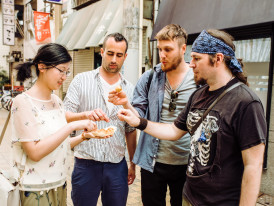
Crowded street food alley with multiple vendors and diners eating while standing
The sushi here might not have the reputation of Tokyo's high-end establishments, but ask any local where to get the best late-night sushi, and they'll point you to places that have been slinging perfect pieces for forty years. These spots don't need Michelin stars – they have something better: neighborhood loyalty.
Here's what every travel blog gets wrong about takoyaki: it's not just about eating octopus balls. It's about the ritual, the community, the shared experience of burning your tongue because you couldn't wait for them to cool down. I've done this probably ten thousand times in my life, and I still can't learn patience when faced with fresh takoyaki.
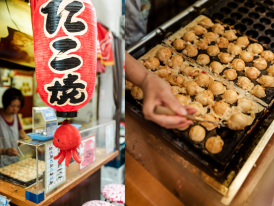
Close-up of takoyaki being prepared with octopus pieces visible,
The best takoyaki spots aren't in the tourist districts – they're in neighborhoods where salarymen stop after work, where kids spend their allowance money, where the cook knows your order before you open your mouth. These places worth exploring have mastered the perfect crispy-outside, molten-inside balance that turns takoyaki from snack food into obsession.
Local insight: The secret isn't just in the batter or the octopus quality – it's in the rhythm. Good takoyaki cooks have a rhythm developed over years, turning each ball at exactly the right moment. You can hear it in the way their tools hit the metal plates.
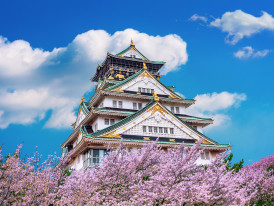
Osaka Castle during cherry blossom season with full pink blooms framing the structure
Every trip to japan seems to include castle visits, but Osaka Castle isn't just another photo opportunity. This place has been destroyed and rebuilt more times than anyone wants to count, and that resilience feels distinctly Osakan. We don't give up easy here.
I remember bringing my Tokyo girlfriend here for the first time. She kept comparing it to the castles in Kyoto, missing the point entirely. Osaka Castle isn't trying to be the most beautiful or the most historically accurate – it's trying to be functional, accessible, and real. Just like the city around it.
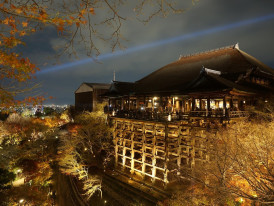
Panoramic view from Osaka Castle observation deck showing the modern city skyline Image by Dong Chan KIM from Pixabay
The observation deck gives you a perspective on how this city sprawls and breathes. From up there, you can see the neon lights starting to flicker on in Dotonbori, the trains snaking between neighborhoods, the way modern and traditional osaka blend without apology.
What the Osaka castle park brings to the table: During cherry blossom season, this place transforms into something magical. But it's not the delicate, Instagram-perfect magic you see elsewhere. It's loud, crowded, slightly chaotic magic where families claim spots with blue tarps and drink beer under the blossoms until late into the night.

Families having hanami parties under cherry blossoms in Osaka Castle Park. Photo by Jerry Wang on Unsplash
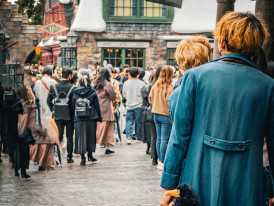
The Wizarding World of Harry Potter entrance with crowds of visitors Image by akio_akky1474 from Pixabay
I was skeptical when Universal Studios Japan first opened. Another American import trying to replant itself in Japanese soil. But this place proved me wrong in the best possible way. It's not just a theme park – it's a perfect example of how Japan takes foreign concepts and makes them distinctly Japanese.
The Harry Potter section, specifically the Wizarding World, is where this theme park magic really clicks. Walking through Hogsmeade feels like stepping into the movies, but with a Japanese attention to detail that goes beyond anything you'll find at other Universal Studios locations. Every stone, every snow effect, every piece of ambient sound is precisely calibrated.
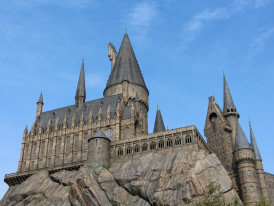
Detailed view of Hogwarts castle replica with realistic weathering and architectural details Image by manseok Kim from Pixabay
Why Universal Studios works in Osaka: This city has always been about entertainment and spectacle. From bunraku puppet theater to modern anime culture, Osaka knows how to put on a show. Universal Studios Japan doesn't feel like a foreign implant – it feels like the natural evolution of Osaka's entertainment DNA.
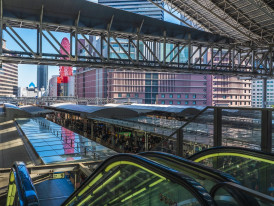
Busy interior of Osaka Station during rush hour with crowds navigating multiple levels. Image by
When people ask about the best things to do in Osaka, I always start with mastering the transportation system – because once you understand how this city connects, everything else becomes possible. Osaka Station isn't just a train station – it's a city within a city. The first time I brought a friend from rural Japan here, she got lost for two hours trying to find the right exit.
The connection to Kansai International Airport through the station system means your trip to japan starts and ends smoothly. No hour-long taxi rides or complicated bus schedules – just clean, efficient trains that run exactly on time.
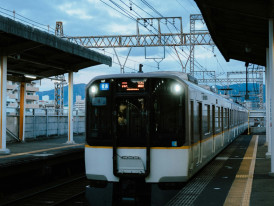
Clean, modern airport express train at platform in Osaka Station Photo by Peter Thomas on Unsplash
How the train stations connect your osaka experience: From central osaka, you can reach Kyoto in forty-five minutes, Nara in an hour, and even Mount Fuji via Shin Osaka Station connections. This isn't just convenient – it's transformative for how you experience the entire Kansai region.
Namba Station deserves its own section because it's where efficiency meets insanity. This underground network connects shopping, dining, entertainment, and transportation in ways that defy logical explanation. I've lived here my entire life and still discover new passages.
The genius is in how everything connects. You can travel from your hotel to dinner to shopping to karaoke to the last train home without ever seeing daylight. During summer or winter extremes, this underground ecosystem becomes essential to comfortable city navigation.
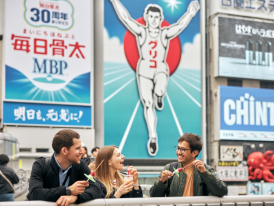
The famous Glico running man sign and other neon lights reflecting in Dotonbori canal
Let me settle this debate once and for all: Dotonbori is both a tourist trap and authentically Osaka, and that's exactly why it works. The bright lights, the mechanical crab, the crowds – this isn't some sanitized version of Japanese nightlife created for visitors. This is how Osaka has always celebrated after dark.
The vibrant nightlife here isn't trying to be sophisticated or subtle. It's trying to be fun, immediate, and memorable. When office workers finish their shifts, they don't want quiet contemplation – they want karaoke, street food, and the kind of laughter that echoes off the canal walls.
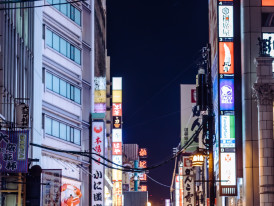
Street-level view of Dotonbori at night with crowds of people and restaurant signs
What makes the lively nightlife work: Osaka's approach to entertainment is democratic. Expensive clubs exist alongside tiny bars where the mama-san remembers your drink order. Michelin-starred restaurants share streets with ramen stands. Everyone's welcome as long as you're ready to have a good time.
Once the main tourist areas quiet down, real Osaka nightlife begins. Hidden bars in basement levels, all-night ramen shops that serve construction workers and club-goers with equal enthusiasm, convenience stores that become impromptu social hubs for the night shift crowd.
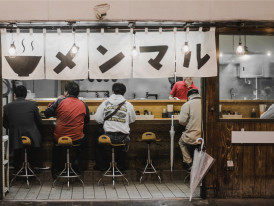
Late-night ramen shop with mix of businesspeople and young people eating at counter.
This is where you understand why Osaka is called the nation's kitchen – because the city never stops feeding people, no matter what time they get hungry or how much they've had to drink.

Umeda Sky Building's distinctive twin towers connected by the Sky Bridge structure
The Umeda Sky Building looks like something from a science fiction movie, but it works because it serves a purpose beyond just looking impressive. The floating garden observation deck isn't just another viewpoint – it's a legitimate piece of engineering that creates a unique urban experience.
The elevator ride to the observation deck is part of the attraction. As you ascend through the building's hollow center, you get a preview of the city sprawling below. It's dramatic without being cheesy – a distinctly Japanese approach to architectural spectacle.
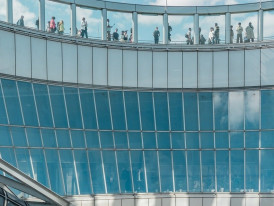
View through the Sky Bridge tunnel with city lights visible through the curved windows. Image by
Why this observation deck beats the competition: Unlike static viewing platforms, the floating garden changes character throughout the day. Morning brings visibility to distant mountains, afternoon reveals the city's industrial complexity, and evening transforms everything into a carpet of lights.
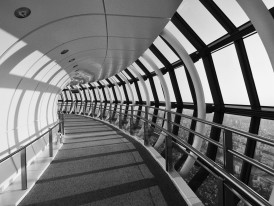
Panoramic city view from the observation deck during golden hour Image by Z3RAJIRAIYA from Pixabay
Spa World sounds like a tourist gimmick, and in many ways it is. But it's also a perfect example of Osaka's approach to taking ideas to their logical extreme. Why have one hot spring bath when you can have baths themed around different countries and time periods?
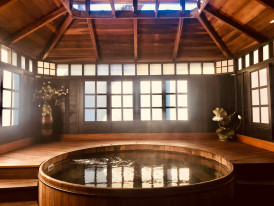
Traditional Japanese onsen bath area within Spa World complex Photo by Cloris Ying on Unsplash
The international dishes concept extends to the spa experience – Roman baths, Finnish saunas, Turkish hammams, all under one roof in the middle of Osaka. It's absurd and wonderful and exactly the kind of over-the-top thinking that makes this city special.
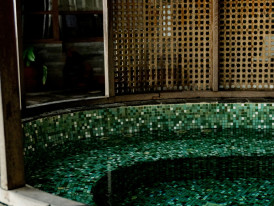
European-themed spa area with classical architectural elements and mineral pools. Photo by Frederick Shaw on Unsplash
What makes Spa World worth your time: After walking dozens of kilometers through the city, dealing with crowds, and eating your weight in street food, your body needs recovery. Spa World provides that recovery in the most entertaining way possible.
The capsule hotels integrated into the complex solve a practical problem while adding to the experience. You can eat, bathe, sleep, and wake up refreshed without leaving the building. It's efficiency wrapped in fun.
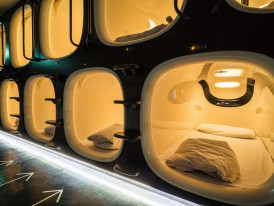
Modern capsule hotel pods

Osaka Bay waterfront with industrial port facilities and city skyline in background
Most visitors never make it to Osaka Bay, and that's their loss. This isn't pristine beach destination – it's working waterfront that shows you how this city actually functions. The massive port operations, the industrial facilities, the way commerce and recreation coexist along the same shoreline.
Tempozan Harbor Village represents Osaka's attempt to create family-friendly attractions without losing the area's maritime character. The giant Ferris wheel isn't just a ride – it's a landmark visible from across the bay, a beacon that helps you navigate the city's geography.
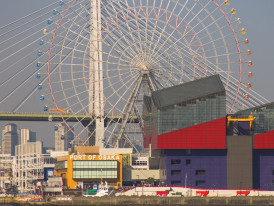
Large Ferris wheel at Tempozan Harbor Village with bay and ships visible.
\ hy this day trip matters: Understanding Osaka means understanding its relationship with water. This city grew because of its position at the mouth of several rivers, its access to trade routes, its ability to move goods efficiently. Osaka Bay shows you that foundation.
The impressive aquariums here, particularly Kaiyukan, don't just display marine life – they tell the story of the Pacific Rim ecosystem. Walking through the spiral path from Arctic to tropical zones teaches you about the ocean currents that shaped the region's history and economy.

Large whale shark swimming in the main tank at Kaiyukan Aquarium.
The genius of Osaka's location becomes clear when you realize how many incredible destinations lie within an hour's train ride. Kyoto with its temples and traditional charm. Nara with its deer park and oldest temples. Each represents a different aspect of Japanese culture, all easily accessible from your Osaka base.
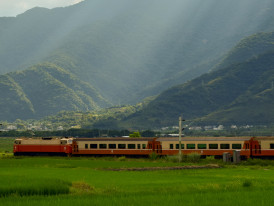
Traditional train traveling through Japanese countryside with mountains in background Photo by Tseng Shiya on Unsplash
But here's what guidebooks miss: these day trips work because Osaka serves as the perfect cultural palate cleanser. After a morning in Kyoto's refined temple atmosphere, returning to Osaka's casual energy feels like coming home. The contrast enhances both experiences.
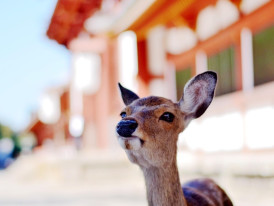
Deer in Nara Park with traditional buildings visible in background. Image by we-o_rd35tvbcfz2ww3poa from Pixabay

The dramatic lion head structure at Namba Yasaka Shrine with traditional architecture
Tucked away behind the chaos of Namba, this shrine features a giant lion head that looks like it could swallow you whole. It's dramatic architecture that serves a spiritual purpose – the lion's mouth is supposed to devour evil spirits and bring good luck to visitors.
What makes this one of the real hidden gems is how few tourists stumble across it despite its central location. Local businesspeople stop here for quick prayers before important meetings. Students visit before exams. It's functional spirituality in the middle of commercial chaos.
Everyone knows about Tokyo Tower, but Tsutenkaku Tower tells a more interesting story. Built in the early 20th century as Osaka's vision of the future, it now stands as a monument to retro-futurism that somehow still feels relevant.
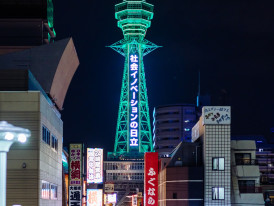
Tsutenkaku Tower lit up at night with surrounding Shinsekai district neon signs
The surrounding Shinsekai district maintains the aesthetic of 1950s Japan – pachinko parlors, kushikatsu restaurants, and entertainment venues that feel frozen in time. It's not preserved as a museum piece – it's still functioning, still serving its community, still evolving slowly.

Street scene in Shinsekai district with vintage signs and kushikatsu restaurants
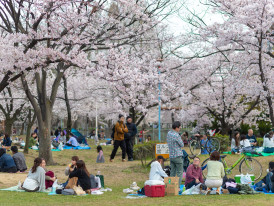
Crowded hanami party in Osaka Castle Park with families eating and drinking under cherry blossoms
Cherry blossom season in Osaka is not subtle. While Kyoto handles hanami with quiet dignity, Osaka throws a city-wide party that lasts for weeks. Osaka Castle Park becomes a temporary city of blue tarps, where families claim spots at dawn and party until midnight.
The full bloom period turns ordinary neighborhoods into tunnel walks of pink petals. But the real magic happens in the evening, when temporary food stalls set up along the blossom routes and the entire city seems to be outside celebrating spring's arrival.

Evening hanami scene with illuminated cherry blossoms and food stalls Photo by Zhaoli JIN on Unsplash
What makes Osaka's cherry blossom season special: It's democratic and inclusive. Expensive hanami parties happen alongside family picnics. Everyone shares the same trees, the same weather, the same brief window of perfect blooms.
Osaka summers are brutal – humid, hot, and relentless. But the city adapts with festivals that embrace the heat rather than hiding from it. Tenjin Matsuri, one of Japan's three great festivals, turns the entire central osaka area into a celebration of summer endurance.
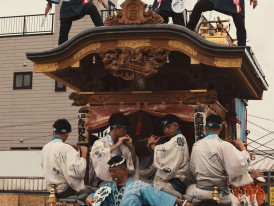
Traditional festival procession during Tenjin Matsuri with participants in historical costumes. Photo by Nguyen TP Hai on Unsplash
The festival's boat procession on the river showcases traditional Japan while fireworks light up the modern skyline. It's a perfect example of how Osaka layers different time periods without trying to choose between them.
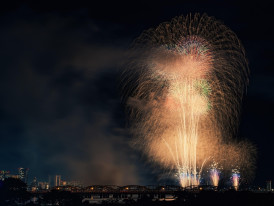
Fireworks over Osaka river during summer festival with boat procession below Image by Kanenori from Pixabay
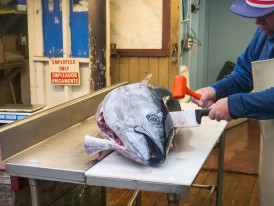
Animated vendor at Kuromon Market demonstrating fresh tuna cutting techniques Photo by Kindel Media pexels
Kuromon Ichiba Market isn't just about buying groceries – it's about understanding how Osaka approaches food as daily theater. Vendors perform their products, customers participate in the selection process, and everyone understands that buying food is a social activity.
The market operates on relationship-building rather than simple transactions. Regular customers get better prices, first access to premium items, and cooking advice thrown in for free. It's commerce as community building.
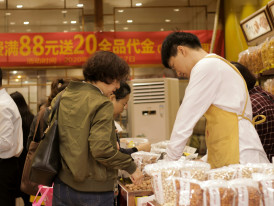
Regular customer receiving personalized service and recommendations at market stall Photo by Enxyclo Studio on Unsplash
What this teaches about Osaka: Food isn't just fuel here – it's the medium through which relationships form and community happens. Understanding this changes how you experience every meal in the city.
Street food in Osaka operates by unwritten rules that, once understood, make the entire experience more enjoyable. Peak times for the best selection, how to order without speaking Japanese, where to stand while eating – these details matter.
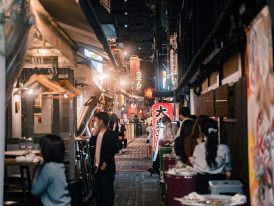
Proper street food eating etiquette with people standing in designated areas Photo by Satoshi Hirayama pexels
The best strategy is to follow local office workers during lunch hours and construction workers during evening shifts. They know which vendors offer the best value, the freshest ingredients, and the most authentic flavors.
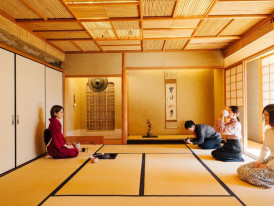
Modern building with traditional tea ceremony experience
Osaka doesn't apologize for embracing modernity while maintaining traditional elements. Tea ceremony schools operate above cell phone stores. Traditional craft workshops share buildings with startup offices.
Why this approach works: It keeps traditional arts alive by embedding them in daily life rather than isolating them as museum pieces. A tea ceremony becomes something you can access on your lunch break, not something requiring a special pilgrimage.
Japanese culture in Osaka isn't performed for tourists – it's lived by residents who adapt traditions to contemporary needs. Buddhist temples hold meditation sessions for stressed office workers. Shinto shrines offer business success prayers for startup entrepreneurs.
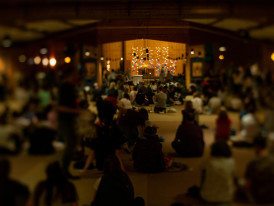
Modern office workers attending temple meditation session after work. Photo by Tomasz Kluz on Unsplash
The result is living culture rather than preserved culture. Traditions evolve, adapt, and remain relevant because they serve current needs while maintaining their essential character.
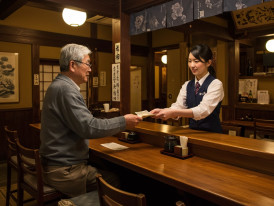
Cash transaction at traditional restaurant with friendly interaction between customer and staff.
The best time to visit Osaka depends on what you want to experience, but spring and fall offer the most comfortable weather and the most active cultural calendar. Summer brings festivals but brutal humidity. Winter brings fewer crowds but limited daylight hours.
Seasonal strategy breakdown:
- Spring: Cherry blossoms, comfortable temperatures, active festival season
- Summer: Intense heat, major festivals, longer daylight hours
- Fall: Perfect weather, autumn colors, comfortable walking conditions
- Winter: Cold but clear, fewer tourists, excellent hot food weather
Your first trip to Osaka should focus on understanding the city's geography and rhythm rather than checking off tourist attractions. Spend time in different neighborhoods at different times of day. Learn how the train system connects various districts. Develop preferences for food vendors and local spots.
First-time visitor priorities:
- Master the train system basics
- Identify your food preferences through market exploration
- Experience both tourist areas and residential neighborhoods
- Learn basic Japanese courtesies for market and restaurant interactions
Osaka operates largely on cash, so plan accordingly. Many restaurants and small vendors don't accept cards, and some traditional establishments prefer cash transactions even when cards are technically accepted.
Basic Japanese phrases go a long way, but Osaka dialect can be confusing even for other Japanese speakers. Don't worry about perfect pronunciation – enthusiasm and politeness matter more than linguistic accuracy.
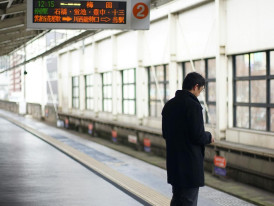
Seamless airport train connection with clear signage and efficient passenger flow. Photo by Tim Medrano on pexels
Being conveniently located at the center of the Kansai region means Osaka serves as your base camp for exploring all of western Japan. Day trips to Kyoto, Nara, and Kobe become routine. Longer excursions to Hiroshima, Mount Fuji, or even Tokyo remain manageable from Osaka's extensive rail connections.
The transportation efficiency isn't just about convenience – it's about mindset. When travel between cities becomes effortless, you start thinking regionally rather than focusing on single destinations. Your trip to Japan expands naturally to include multiple perspectives and experiences.
Kansai Airport serves as your gateway to the region, with rapid trains, clear signage, and efficient luggage services ensuring smooth transitions from international travel to local exploration.
Why this matters: When basic logistics work flawlessly, you spend more energy on discovery and less on navigation stress. The quality of airport connections sets the tone for your entire trip.
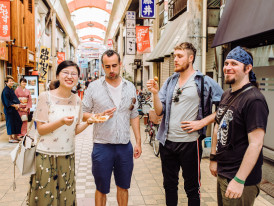
Personal moment of local resident enjoying simple street food with genuine satisfaction
After twenty-eight years and countless trips around Japan and the world, I keep returning to Osaka because it never pretends to be anything other than itself. The city doesn't try to impress you with perfection – it wins you over with authenticity, energy, and the best damn food you'll ever eat.
Every Osaka experiences I share with visitors reinforces why this city matters. It's not the most beautiful place in Japan, the most historically significant, or the most internationally famous. But it's the most genuinely itself, and in a world of increasingly homogenized travel experiences, that authenticity becomes precious.
The reasons to visit Osaka go beyond any list I could compile. The city reveals itself gradually, building relationships with visitors who invest time in understanding its rhythms and values. You don't just see Osaka – you participate in it, contribute to it, and ultimately become part of its ongoing story.
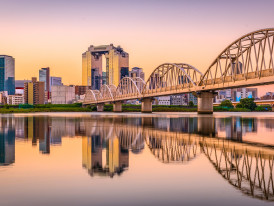
Sunset view of Osaka with mixture of old and new architecture, capturing the city's essence.
Come for the food, stay for the people, return for the memories that only happen in places brave enough to be completely themselves. That's Osaka in one breath – flavors, jokes, and ballparks, exactly as promised.
About the Author: Daiki Morimoto is an Osaka native who has spent nearly three decades exploring every corner of his hometown. When he's not discovering new ramen shops or debating the merits of different takoyaki techniques, he helps visitors experience the real Osaka through authentic local connections.
